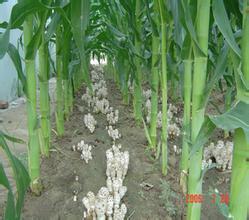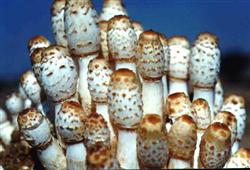The benefit of making good use of space is doubled to grow Coprinus comatus under black fungus.

The construction of the shed is semi-underground. Dig 60 cm from the ground and build adobe on three sides, high in the north and low in the south. Dig the border in the shed, the border is 80 cm wide and 35 cm deep, and the corncob is dried and crushed to the size of soybeans. The corn straw is dried and rootless and crushed into 3 to 5 centimeters long. Culture material formula black fungus formula: corncob 45%, hardwood sawdust (or cottonseed husk) 30%, wheat bran 15%, corn flour 5%, phosphate fertilizer 1%, lime 2%, gypsum 2%, sugar a little, potassium dihydrogen phosphate 0.1%. Soak the corncob in 2% lime water for more than 10 hours. Then mixed with other materials into a 17 × 35 cm low-pressure polyethylene bag, sterilized under normal pressure for 8 hours, cooled and inoculated under aseptic conditions. After inoculation, it was put into the culture room for bacteria, and the room temperature was kept at about 23 ℃. Coprinus comatus formula: 3.5 kg of crushed corn straw, 5 kg of wheat bran, 2 kg of lime, 0.5 kg of gypsum, a little sugar, 2.5 kg of dried chicken manure, 0.5 kg of phosphate fertilizer, 1.5 kg of cake fertilizer, 50 grams of potassium dihydrogen phosphate, 100 grams of urea and 50 grams of carbendazim. The corn stalks were soaked in 3% lime and 0.1% chlorpromazine water for 10 hours. after water control, they were mixed with wheat bran and dried chicken manure and fermented. When the material temperature reaches 60 ℃, turn the pile after 8 hours and repeat it for three times. Add other accessories every three times when turning the pile. The fermented noodle is brown, has no peculiar smell, and the water content is 65%. The material temperature is below 28 ℃ and put into the border. The bacteria were put into the material by the combination of layer sowing and hole sowing (7.5 kg bacteria for every 50 kg dry material). The material was 30 cm thick. The material surface is covered with newspaper and agricultural film, and the temperature in the shed is kept at about 20 ℃ to cause bacteria. Management (1) after the bag of Auricularia auricula is full, begin to go into the shed to lift the bag, 8 for each rope. Used for soda water to wash bags and disinfect. Each bag is marked with 8 "ten" according to the shape of "product" and goes out of the ear. (2) after the Coprinus comatus is full of bacteria, insert a hole 3 cm deep every 30 cm, and add nutrient solution. The material surface is sprayed with triacontanol and gibberellin to increase the yield and turn tide quickly. Auricularia auricula cultivation 50 kg dry material to produce 5 kg dry ear, Coprinus comatus every 50 kg dry material to produce fresh mushroom about 60 kg. The production of Auricularia auricula and Coprinus comatus with corncob and cornstalk has a wide range of raw materials, simple method and low cost.
- Prev

How to interplant Coprinus comatus in chili field
Interplanting Coprinus comatus in pepper field is a good method to imitate wild cultivation of Coprinus comatus, which can save the cost of building mushroom house, does not occupy space, and can greatly improve the economic benefit per unit land area. Generally, after the pepper is planted, trenches are opened, materials are laid and bacteria are spread in the middle of the pepper row. For managing and harvesting mushrooms.
- Next

Imitating Wild cultivation techniques of Coprinus comatus
The growth temperature of imitating wild Coprinus comatus is between 10 ℃ ~ 24 ℃, and the mushroom is produced from March to June in spring and from September to November in autumn. If imitating wild cultivation in plastic greenhouse, seeds can be sown from October of that year to March of next year, mushrooms can be produced from November of that year to June of next year, and can be produced twice a year. Each cultivation cycle can produce 5-6 crops of mushrooms.
Related
- Fuxing push coffee new agricultural production and marketing class: lack of small-scale processing plants
- Jujube rice field leisure farm deep ploughing Yilan for five years to create a space for organic food and play
- Nongyu Farm-A trial of organic papaya for brave women with advanced technology
- Four points for attention in the prevention and control of diseases and insect pests of edible fungi
- How to add nutrient solution to Edible Fungi
- Is there any good way to control edible fungus mites?
- Open Inoculation Technology of Edible Fungi
- Is there any clever way to use fertilizer for edible fungus in winter?
- What agents are used to kill the pathogens of edible fungi in the mushroom shed?
- Rapid drying of Edible Fungi

